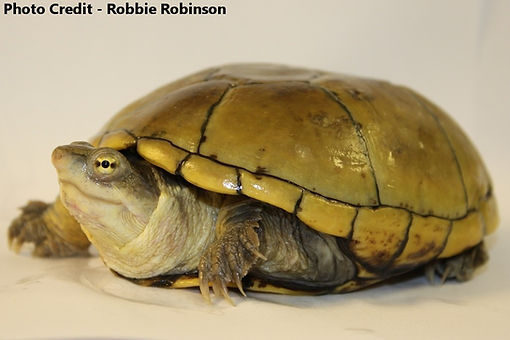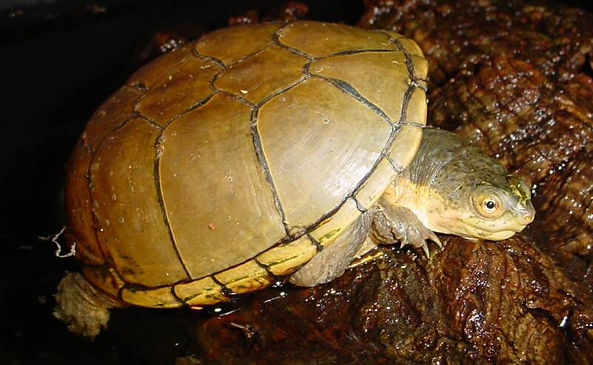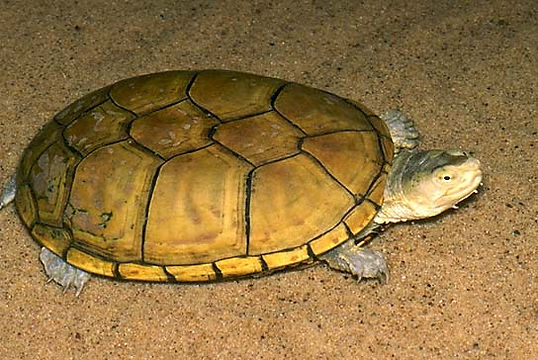17-Razor Backed Musk Turtle
Sternotherus carinatus
Razorback Musk Turtle Care Sheet
courtesy to :razorbackmusk.blogspot.ae
I thought I might as well make a Razorback Musk Turtle care sheet, as this is a blog about them so feel free to ask questions in the comments if your unsure of anything!
Scientific Name:
Sternotherus Carinatus
Description:
Razorbacks are of course known for their razor-like back. However don't get mixed up with other baby Musks, as most Musk turtles start out with a razor-like shell. Razorbacks also have a pale skin with small blackish dots. They will grow to 5.5Inches MAX, so not too big unlike Sliders, which will need an indoor/outdoor pond.
The Setup:
It is very important to get the setup right, as most people don't take into account what is essential.
-
You will need to get the biggest tank you have room for, all Musk turtles are "bottom walkers", meaning they forage on the riverbed looking for food. So you will need a large surface area.
-
I would personally suggest sand for a substrate, not only is it cheap from Argos, Tescos etc, but I feel it is most natural for the turtle. They also like to dig in the sand so it gives them something else to do! Might want to wash it a few times before putting it in the tank.
-
Remember to include plenty of live plants AND fake plants. The turtles will destroy the live plants, but they help maintain the water quality. Plastic plants are used, otherwise you will be spending endless amounts of money on live plants, but it is also good to have live plants, obviously because it's natural but turtles can get stuck in plastic plants and drown. So please watch out. Musk turtles are not great swimmers so will require plants and other objects to help them get to the surface to breathe.
-
Other objects like cork bark or mopani wood are great for stratching their shells against, anything that gives them somewhere to hide is needed too, like a cave etc, so they feel safe and not like they are on show.
-
Turtles are messy creatures, therefore you will need a good powerful filter. A turtle can never have too much filtration. The Ehiem Classic Range is supposed to be the best on the market, Zoo Plus sell it very cheap, with great discounts and free shipping. External are always best as they deal with waste more efficiently. Internal filters also have fast currents, when musk turtles are found in slow moving rivers.
-
Heating and Lighting is also very important, you will need a UV light. The Exo Terra, 13w 10.0 is very good for musks. You will also need a heat lamp, which can be a normal household light, that gives off heat.
-
Temperatures for a baby turtle in the water should be 24-27 Celcius, you will need a water heater for this. Once they are adults you can remove the water heater and keep the water at room temperature (22-23 Celcius) if you have a cold house then a heater is required again.
-
You will also need a basking area. Even though musk turtles dont usually bask it is always important to provide them with a place to get out of the water incase they are ill or tired etc. Razorbacks are known to bask more than any other turtle so dont be suprised if your razorback likes to climb out of the water.
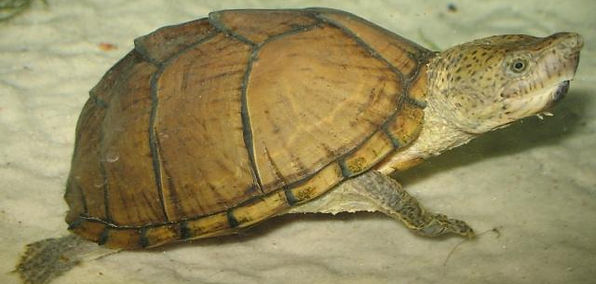
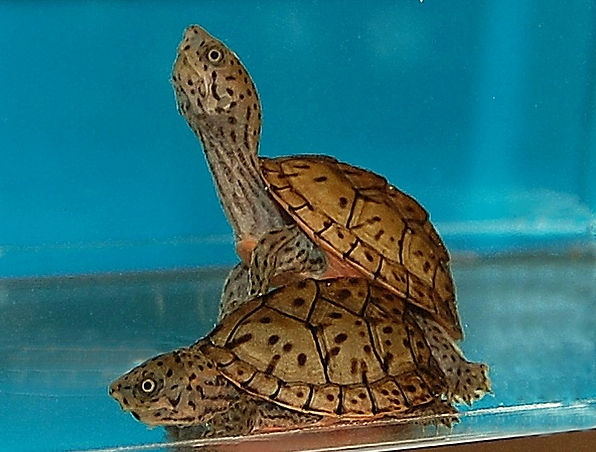
Water Depth:
Razorback musk turtles are more competent swimmers, they can withstand deeper water than any other musk turtle. For baby musk turtles I would suggest around 4-5 inches of water, with plenty of plants to climb up. For an adult no deeper than 14 Inches. A shallow water area of about 3 Inches is also a good idea. This can just be another basking platform underwater. I wouldn't put an adult razorback in water deeper than 14 inches.
Feeding :
Pellets are the main source of food (reptomin), but they can also eat bloodworms, earthworms, salmon, shrimp, prawns and hikari tropical sinking wafers. Adults should be fed every other day. Imagine the turtle's head is hollow, you need to fill that head with food.
Compatibility With Other Turtles:
Most people ask if you can keep musk turtles with another species of turtle. Musk turtles require a completely different setup to other turtles. They are poor swimmers that require shallow water unlike sliders that require deep water. The two species wouldnt work together. On top of that musks are very small compared to other turtles and would get knocked around in the tank or pond by much larger turtles.
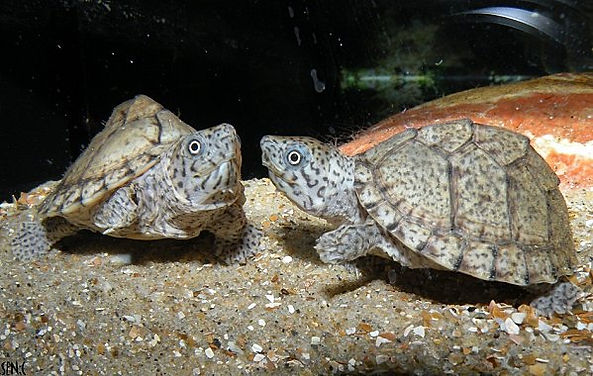
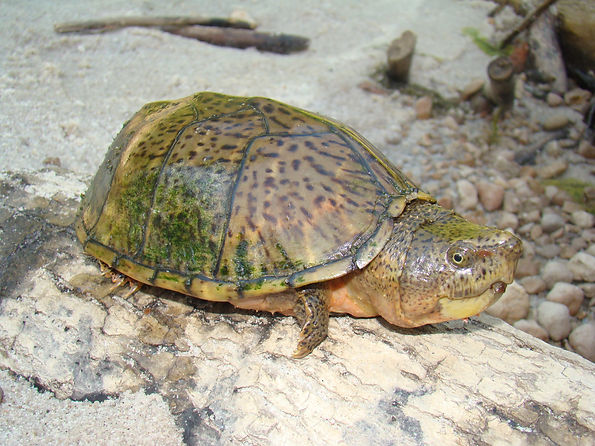

18-New Guinea Sideneck Turtle
Chelodina siebenrocki
courtesy to : http://www.austinsturtlepage.com
NAME Australian snake - necked turtle - Chelodina siebenrocki photos
CLASSIFICATION ORDER: Testudines, SUBORDER: Pleurodira, SUPERFAMILY: ***, FAMILY: Chelidae,SUBFAMILY: ***, GENUS: Chelodina
DISTRIBUTIONcoastal swamps and offshore islands of New Guinea
SIZEcarapace length up to 14 inches
IDENTIFICATIONthe shell, egg like in shape, is slightly domed, keeless and the scutes are thin and smooth. The head is flat and covered with a pattern reseambling small irregular scales. The chin has a pair, or more, of barbels. The neck is long and muscular. The legs are webbed. The soft parts are grey, with the head slightly greenish or yellowish, and underside of the body whitish.
IN CAPTIVITYas this is a tropical turtle, the water should be kept warm - around 25 to 27 C - all year round, and always clean ( Chelodina seems to be prone to get skin fangus easily ). Food: all kinds of live food including mainly fish, but also small creyfish, earthworms andfrogs. It also loves the commercially available turtle foods.
BEHAVIORthe turtle doesn't bask and prefers spending its time in deep soft mud. It is not aggressive, doesn't bite and does not mind to be handled. It will recognize its keeper with time and make an interesting and cute pet turtle.
REPRODUCTION the eggs are laid in May at the end of the wet season and hatching takes place in November or December, at the beginning of the wet season. The hatchlings are about 1.4 inches ( 3.7 cm ) long and have dark brown spots on the carapace.
Carapace:
The carapace is typically brown and somewhat elongated with the broadest portion of the shell being just past the middle. The scutes have small creases or wrinkles and are either brown or black in color. The posterior edge of the carapace is most often smooth but can sometimes be slightly serrated. The underside of the carapacial rim is light brown to yellow.
Plastron:
The front of the plastron is wide and tapers to a rounded edge while the rear tapers down with a deep notch. The plastron is smaller than the carapace and the bridges are narrow. Both the plastron and the bridges are yellow and can sometimes have dark seams.
Head: The head is large, wide and long and covered with irregularly shaped scales with the nose staying within the curvature of the head. The top jaw has neither cusp or notch bottom jaw is flat with small, multiple chin barbels. The neck is thick and very long (more than 75% of the length of the carapace) and is covered with a variety of tubercles along its length.The head and neck are usually gray, brown or olive in color with the underside usually being a lighter variant of the top and can sometimes be white.
Additional: The limbs and the tail of Macrochelodina rugosa are usually a mild gray. Males have a much longer and thicker tail than females. They also possess several large, transverse scales on the front of the front legs.
Size: .Both males and females may attain a SCL of between 14" and 16 inches.
Can be found along the northern edges of Australia (Cape York Peninsula west to the Kimberly District of western Australia)
TEMPERATURE RANGE (°F)
-
Air Temperature: High 80's to Low 90's
-
Basking Temperature: High 80's
-
Water Temperature: High 70's
Some keepers have kept rugosa long term successfully in water temperatures in the range of 74 - 76 degrees.
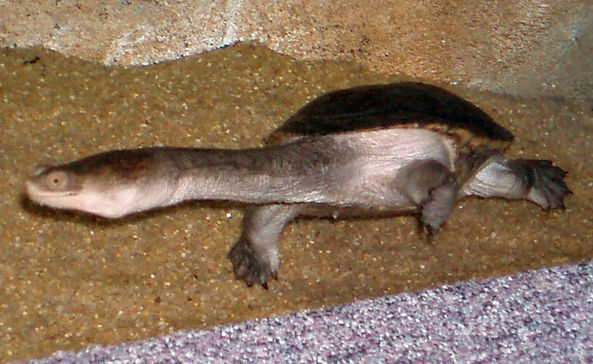
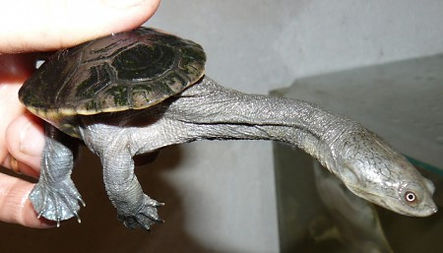
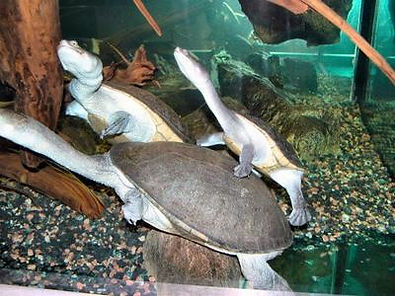
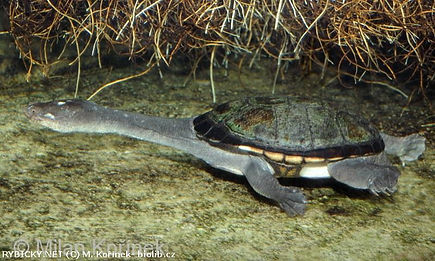
CARE DIFFICULTY :
Due to their size (not just the carapace length but also taking into consideration their neck) these turtles can be difficult to house, hence their being classified as an intermediate difficulty level. Not many beginning keepers are able to keep a species that can attain this size with the additional length of the neck. It can make for some interesting housing challenges. Additionally, as this species are not common baskers, they can sometimes develop shell situations which require treatment.
CAPTIVE DIET:
As with all turtles, variety is the key to success. While it is believed that rugosa are indeed true carnivores, they will sometimes accept leafy greens and veggies. In feeding a carnivorous/omnivorous turtle, it is commonplace to freeze their food for storage purposes but it should be thawed completely before offering to your turtles. Commercial foods on the market are availabe, such as Mazuri Aquatic Turtle Diet, AquaMax 500 and ReptoMin. Live should should be provided routinely for feeding such as prawns and fish. Bloodworms, blackworms, earthworms, snails, crickets and other insects are also encouraged as a part of their captive diet.
RECOMMENDED FEEDING SCHEDULE:
Most rugosa lose any shyness relatively quickly and are voracious feeders. They appear to take on the "eat it now, taste it later" concept when feeding. Their strikes are indeed snake-like and adult rugosa especailly have a powerful bite so it is common to overfeed them due to the entertainment value of watching them feed. I recommend feeding adults twice per week while sub-adults get fed 3 times per week. Juveniles should only be feed possibly every other day while fresh hatchlings should get a daily meal. When feeding, it is important to ensure they receive a quality amount without overstepping the boundaries and falling into overfeeding. A good rule of thumb is to feed them enough pellets that will fit into their head or when feeding thawed live food, you should feed sparingly.
CAPTIVE HABITAT :
M. rugosa are not basking creatures. They have been known to bask, however, it's most definitely a rarity. A basking area should be provided. Over the years, I have my rugosa with several habitats and basking options, of which none have been seen to have basked more than once or twice in 8+ years. Because of this, I have gone ahead and removed the basking area and replaced it with a shallow water shelf and this has become a favorite place for hanging out and sleeping.
RECOMMENDED ENCLOSURE :
These turtles require a sizeable enclosure not only because of their size, but they are active turtles. When selecting a habitat for this species, keep not only carapace length in mind, but also neck length (potentially 75% of the length of the carapace). While not recommended for indoor set-ups, adults can be housed in aquariums no smaller than 150 to 200 gallons for a single turtle. Adding additional turtles to a habitat requires that you increase the size of the tank accordingly by half (ie; 1 male = 150 gallons, 2 males = 225 gallons, etc). Stock tanks also make great alternatives to glass an acrylic aquariums. As everything on this website, these are recommendations and not hard-set "must do" rules.
WATER DEPTH :
Accomplished swimmers even as fresh hatchlings, Macrochelodina rugosa enjoy deep water habitats.
COMMUNITY HABITAT:
Most do extremely well with other turtles from the same climate and are generally docile towards tankmates, although, as with any species, there are individuals who show aggression towards other turtles even when adequate room is provided.
Macrochelodina rugosa will lay their eggs in shallow water during the late wet/early dry season. When the dry season comes, the water level drops and air enters the nest and triggers development of the embryos inside the eggs. They can may between 10 and 16 elongated eggs.
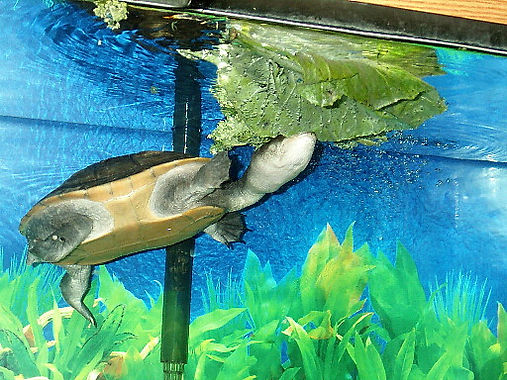
19-Arakan Forest Turtle
Heosemys depressa
Heosemys grandis (Gray 1860) species description and care sheet
courtesy to : www.heosemys.org
1 Anatomy:
H. grandis is sometimes called Orange Headed Temple Turtle, because it has orange spots on the face. The carapace has a single, well-shaped keel and spiny marginals.
The forelimbs are covered with scales, the toes are webbed.
The plastron is yellow with radiating dark lines on every plate. As the turtle grows older this pattern fades away. The anterior and posterior plastron are serrated. In adult females the plastron is slightly movable.
Plastral formula: abdominal › femoral › pectoral › anal › ‹ humeral › ‹ gular (i.e. The interabdominal seam is the longest, then the interfemoral etc.)
The maximum size is up to 43,5 cm (17"); its maximum weight up to 12 kg (26,4 lbs).
H.grandis has 2n=52 chromosomes.
1.1 Sexing H.grandis
In contrast to most turtle species (sub-)adult female grandises are on average smaller than males, and have a shorter tail. Males usually have a concave plastron, and a thicker tail than females.
Hatchlings show no sexual dimorphism. The only indication of their gender is the temperature at which they have been incubated. It can take up to four years before you can determine their gender with certainty.
1.2 Distinguishing H.grandis from other species
Heosemys spinosa is smaller and has a rounder shell. Its toes are only partially webbed. Juveniles have spines all around the shell.
Cyclemys species are smaller than H. grandis, and have a proportionally smaller head.
Cyclemys dentata doesn't have a bicuspid upper jaw. Adults have a plastral hinge.
Cyclemys tcheponensis has four stripes extending from the neck forward over the side of the head
• Heosemys identification key
• related forum topic


2.1 Habitat :
Swampy wetlands, deciduous forest and mountain streams. It spends much time on land partially hidden under shrubbery.
2.2 Distribution :
South Myanmar, southern Vietnam, Cambodia, Laos, central & west Thailand and peninsular Malaysia. There is not enough data to confirm its occurrence (past or present) in Singapore.
Protected in Thailand, Myanmar and Cambodia.
• Giant Asian pond turtles in the wild and in captivity, around the world
• Heosemys grandis in museum collections
• Distribution/Status of H. grandis in Singapore


Cyclemys dentata Cyclemys tcheponensis Heosemys spinosa
2.3 Other turtle species :
H.grandis shares some of its natural habitat with Amyda cartilaginea, Indotestudo elongata, Manouria emys, Chitra chitra, Cuora amboinensis, Heosemys spinosa and (introduced) Trachemys scripta elegans, and can encounter any of these in the wild.
3 Behaviour :
The species has been kept together with the following species, without any reported complications: Trachemys scripta elegans, Pelusios sinuatus, Chrysemys concinna, Cuora amboinensis, Cuora trifasciata, Batagur baska, Callagur borneoensis, Orlitia borneensis, Pseudemys rubriventris, Terrapene carolina, Rhinoclemmys pulcherrima, Rhinoclemmys diademata, Testudo hermanni & Ocadia sinensis. They are generally friendly to other species. However, some adult males can be very agressive and should be separated from all other turtles.
Unlike most other turtle species, H.grandis doesn't display any subtle courtship behaviour. They bite at the neck, legs and head of females. Quoting an expert: 'Males' idea of reproduction often skips courtship and goes straight down to business, regardless of the female's consent.'
4 Husbandry :
A vivarium for an (sub-)adult H.grandis should have a water area & a dry area with some hiding places. If the dry area doesn't have any hiding places, the turtle will stay in the water.
A maximum day temperature of 24C-28C is recommended, although H.grandis already feels happy with 12C. The temperature may vary to simulate the dry & wet seasons.
They are mostly aquatic as hatchlings. As they grow older, they become more terrestrial.
5 Nutrition:
According to Peter Pritchard, 'this species eats almost anything edible', but wild animals feed mainly on fruit & aquatic plants. Recommended food products include: all kinds of (low fat) meat & fish, fruit, lettuce, aquatic plants like Elodea, Ceratophyllum, Azolla, Vallisneria. Giant Asian pond turtles don't eat live food and some don't like fish. Cuttlefish bone should always be available to them. Don't overfeed them, they easily get fat.
• dietary requirements of Asian turtles
• forum topics on feeding
6 Breeding:
Wild animals in South East Asia nest at the end of the rainy season, late November-early December, and hatchlings emerge at the start of the next rainy season, May-June.
H. grandis lays 2-6 oval eggs (depending on the size of the female). The eggs are 55-65 mm in size and weigh 50-60 g.
Some females display nesting behaviour (wandering around & digging) after the actual egglaying.
In captivity, the eggs need an incubation period of three and a half to six months, at a temperature of 29C and 100% humidity. Hatchlings weigh about 23 g and have a large fontanelle or "soft spot" in the middle of the plastron.
• reference: Ernst/Barbour (1989)
• Incubation temperature and sex determination
6.1 Hybrids:
The Geoemydidae family is notorious for producing hybrids, but I don't know of any confirmed cases of a H.grandis hybrid. A Heosemys grandis x Ocadia sinensis hybrid has been mentioned on a Kingsnake-forum once (view source) but I have not been able to verify this.
7 Health issues
7.1 Parasites
Heosemys grandis are reported to carry Entamoeba invadens, a common amoebic protozoan; Falcaustra kinsellai, Serpinema octorugatum, Oswaldocruzia malayan, Spironoura siamensis, Spironoura stewarti, Zanclophorus purvisi, Quasichorchis purvisi, Stunkardia dilymphosa andTelorchis clemmydis
• sources: Murray (2004), Sharma e.a. (2002) Bursey and Freeman (2005)
20-Twist Necked Turtle
Platemys platycephala
SCIENTIFIC NAME:
Platemys platycephala
ADULT SIZE:
Up to 7½"
DIET :
In the wild, they feed upon fish, snails, amphibians, insects and worms and some vegetation.
TEMPERATURE RANGE (°F):
Air Temperature: Low to mid 80's
Basking Temperature: Mid to High 80's
Water Temperature: Low to mid 70's
WATER pH LEVEL: 5.2 - 6.0
HABITAT :
Shallow rainforest streams, pools and marshes.
DISTRIBUTION :
Northern South America.
BEGINNER TURTLE:
No
CAPTIVE HABITAT:
Platemys platycephala requires a large area of land as well as a shallow pool of water. They are at home as much on the land as they are in the water, so a significant amount of both is required. They prefer shallow, soft-bottomed habitats, with a lot of vegetation. Either artificial plants or aquatic plants that can withstand the low pH requirements are suggested. The substrate, if used, should be sand or a fine gravel. UVB lighting is required, as well as a heat lamp over the designated basking area. A submersible heater is also recommended.
RECOMMENDED ENCLOSURE:
Recommended size for a single adult Platemys platycephala would be a 55 gallon aquarium as a minimum (75 or larger preferred). This will provide adequate swimming area and a good amount of land for the turtle to move about, as well as assisting the filtration in maintaining good water quality. For additional Platemys platycephala, I would recommend adding 30 gallons of tank space per additional turtle at a minimum. A longer and wider tank is preferred as they do not require deep water.
Stock Tanks and Rubbermaid containers also work well. The same space recommendations remain the same.
CAPTIVE DIET :
In captivity, they do well on Mazuri and ReptoMin, Reptile/Pond 10, Cichlid Sticks, fish, crickets, assorted worms and insects, and some vegetables.
COMMUNITY HABITAT:
It is recommended that if they be kept in a community habitat, that the other turtles within the community have the same requirements of shallow water as well as being from the same region as the Platemys platycephala.
OTHER INFORMATION:
Platemys platycephala are highly susceptible to fungal infections and close attention to their water conditions is a must. They are sociable turtles and will gladly accept food by hand.
21-Reeves Turtle
Mauremys reevesii
Reeve's Turtle Care Sheet
courtesy to : www.reptiles magazines.com BY PAUL VANDER SCHOUW


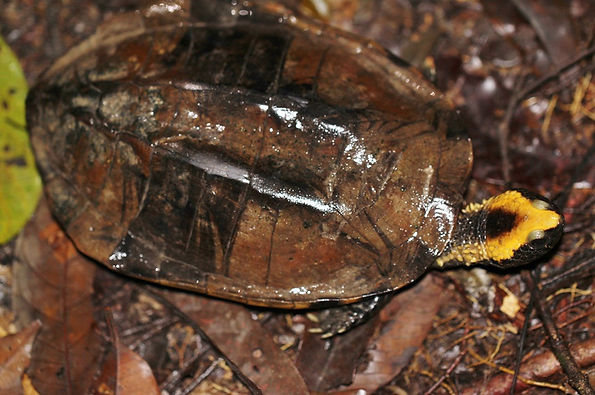



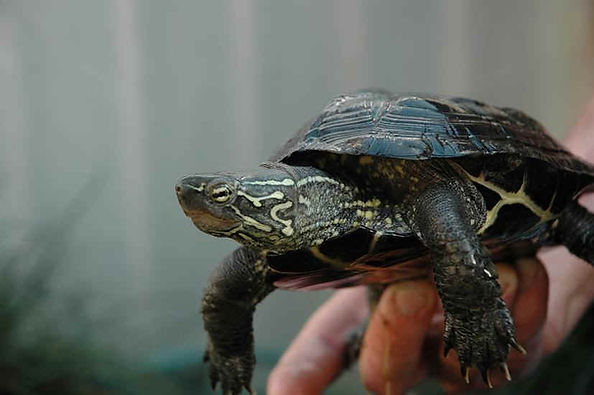
Reeve’s Turtle (Mauremys reevesii)
Reeve’s turtle is the smallest member of the genus Mauremys, one of the largest genera of the Old World turtle family Geoemydidae. Their range extends across central and eastern China, as well North and South Korea, Taiwan and Japan, where they inhabit lakes, ponds and small streams. This species shows a preference for slow-moving or still water with soft bottoms, abundant aquatic vegetation and ample basking sites. It has also been recorded in swamps, marshes and even flooded rice paddies.
Although there appears to be several distinct morphological forms (as might be expected with a wide-ranging species like M. reevesii), their habits and requirements are very similar. For the purpose of captive husbandry, they may all be cared for in the same manner.
Availability:
Reeve’s turtles breed readily in captivity, and are frequently produced by hobbyists and, especially in China, turtle farms alike. As with most temperate species, Reeve’s turtle breeding is seasonally restricted to spring and summer, so captive bred babies are most commonly available from May through September. However, given the significant numbers of babies produced annually, they are usually available year-round, and their pricing is relatively low for an exotic species.
Size:
In addition to their charming personality, another appealing aspect of Reeve’s turtles is their manageable adult size. Even the larger ‘megalocephala’ form of Reeve’s turtle rarely exceeds 9 inches, and specimens of the typical form are not normally more than 6 inches in length. Females attain a larger adult size than males, but unfortunately it is not possible to determine the gender of hatchling turtles from outward physical appearance alone.
Life Span :
Reeve’s turtles have been known to live for over 20 years in captivity, so they can truly be a longtime companion. With proper diet, housing, and care, one can reasonably expect their Reeve’s turtle to live for at least 10-15 years.
Captive Habitat
Provided that some minimal housing requirements are provided, captive housing for Reeve’s turtles can be as simple or elaborate as the keeper decides to make it. Because Reeve’s turtles are not the best of swimmers, the depth should be kept relatively shallow, and about 3 times the turtle’s shell length should be considered a safe maximum. However, water that is too shallow presents a potential drowning hazard as well, because the turtle may not be able to right itself if it gets turned upside-down. So the water depth should never be less than about 1.5 times the length of the turtle’s shell. A basking area, on which the turtle can leave the water completely, with a good basking light to help the turtle thermoregulate, is an absolute must. An underwater hiding place should be provided as well, with care taken to ensure that the turtle cannot get trapped and drown. Non-toxic live or plastic plants can be provided for hiding and foraging, though the turtles will eventually shred any live plants whether they eat them or not. Although the tank bottom can be left bare, substrate (sand, gravel, etc.) can be used but should be sized such that it either cannot be swallowed or will pass easily through the turtle’s digestive tract.
Because they are lively and active turtles, Reeve’s turtles should be provided with as much room as possible. At a minimum, a single baby or Reeve’s turtle should be provided about 5 gallons of water volume; this does not mean a 5 gallon tank, but at least a 10 or 15 gallon tank partially filled so that there are actually 5 gallons of water. Increase the volume of water by 2-3 gallons for each additional baby turtle. As the turtle(s) reach adulthood and beyond they should be provided with a minimum of 20 gallons of water volume for the first turtle, with an additional 10 gallons of water volume for each additional turtle.
Reeve’s turtles are adaptable, and can be readily housed in practically any suitably sized tank. Stock tanks, glass aquariums, plastic totes, and garden ponds can all be furnished appropriately for housing individual or groups of Reeve’s turtles. They can be maintained indoors or out, and adequate protection from predators as well as escape prevention measures should be provided in either case.
Lighting & Temperature:
As long as there is a good dietary source of vitamin D to metabolize calcium, UVA/UVB lighting can be provided but is probably not necessary. A good heat-emitting light should always be provided over the basking area, and if necessary either incandescent or fluorescent lighting can provide additional illumination. A household outlet timer can be employed to cycle the lighting on and off to provide a reasonable day/night cycle, and can be adjusted periodically to the appropriate seasonal photoperiod. The sun will of course provide heat and UV rays for turtles maintained outdoors, and no further lighting is necessary.
Temperature gradients should be provided for the water, ambient air, and basking area. Water should be maintained within the range of 70°F-80°F, ambient air between 75°F-85°F, and basking area between 85°F-95°F. Remember that temperatures within an aquarium – especially if there is a hood or cover installed – will likely differ from the temperatures within the surrounding room, so it is important to periodically check the actual temperatures in the tank rather than just relying on a general indoor thermometer/thermostat.
Diet & Feeding:
There is a wide variety of commercial turtle food available on the market, and most have been formulated to provide optimum nutrition for aquatic turtles at all stages of growth. Pay attention to ingredient labels, and look for the following constituencies:
-30%-40% protein
-Low fat content
-Vitamin D
-Calcium (Ca) to phosphate (Ph) ratio at least 2:1
-Vitamin and mineral supplementation
Reeve’s turtles are omnivorous, and in addition to prepared foods they will accept both animal and plant matter with equal enthusiasm. Along with fish, worms, and insects, they can also be offered green leafy vegetables as well as aquatic plants such as water lettuce, water hyacinth, and duckweed.
Health :
Provided with suitable housing and diet, Reeve’s turtles will be active and energetic inhabitants of any turtle tank. But as with any organism, illness and disease can adversely affect them. Some indicators of health problems include:
-
Swollen or sunken eyes
-
Listing or inability to submerge
-
Gaping or frothing at the mouth, or bubbles in the nose
-
Excessive basking or refusal to enter the water
-
Inability or refusal to feed
-
Asymmetrical or irregular growth
-
Obvious discoloration or open wounds on the skin or shell
-
Any other abnormal appearance or behavior
If any of the problems listed above are noted with a captive Reeve’s turtle, immediate veterinary attention is necessary. Be sure to use a vet that specializes in turtles and tortoises, or at least reptiles and exotic animals. A list of local reptile vets can be found at www.arav.com.
Temperament & Handling :
Although not truly social animals, Reeve’s turtles are capable of cohabitating with turtles of their own and other species with similar housing needs. Both sexes can exhibit dominant or territorial aggression, but this behavior is usually not severe enough to inflict serious injury as long as adequate space and hiding areas are provided. Still, it may be necessary to provide a larger habitat or even entirely isolate offending turtles if consistent aggression is noted.
Reeve’s turtles are not domesticated animals that thrive on human affection and contact, and they should not be handled except as a matter of necessity. Occasional handling to inspect the turtle for health or injuries, and occasionally relocating turtles to alternate containers for cleaning and maintenance of their primary habitat is acceptable. In any case, handling is best kept to an absolute minimum. Despite appearances to the contrary, handling is stressful to the turtle and subjects the handler to biting and scratching by the turtle. And as always, thoroughly washing hands with soap and warm water before and after a turtle or any related materials or equipment has been handled will help to avoid any disease transmission between human and turtle.
22-Gibba Turtle
Phrynops gibba
Mesoclemmys gibba, known as the toadhead turtle or gibba turtle, is a small side necked turtle found in a wide area of South America, in Peru, Ecuador, Colombia, Venezuela, Trinidad, Guyana, Surinam, Paraguay, and parts of Brazil.
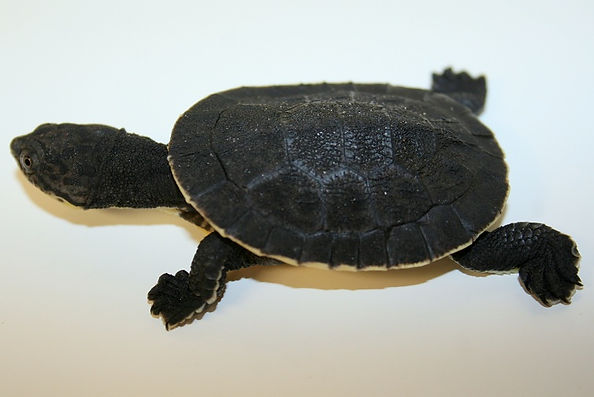
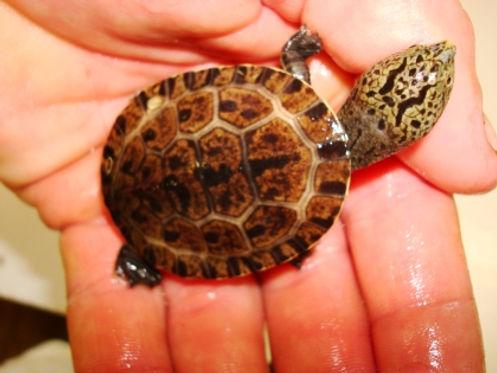

The ellipsoidal, slightly bowed carapace (to 23.3 cm) has a medial keel, is somewhat serrated, has a shallow supracaudal notch. Its surface is smooth or slightly roughened. Vertebraes are broader than long and the 3rd to 5th may bear a small posterior projection on a low keel. Neural bones vary from none to five, but, if present, they are rudimentary and never contact the nuchal (Pritchard and Trebbau, 1984). The carapace is chestnut brown to dark gray or black. The plastron is well-developed and slightly upturned anteriorly. Its intergular scute completely separates the gulars, but not the humerals, and is shorter than its distance from the abdominals. The posterior plastral lobe curves inward and the anals are deeply notched posteriorly. The plastron is red brown to yellow with a brown blotch on each scute, and a narrow yellow border may occur anteriorly and posteriorly. Bridge and undersides of the marginals are brown to yellow. Together, the head and neck are considerably shorter than the carapace. Dorsally and laterally, the head is covered with numerous convex scales; those between the orbit and tympanum are smaller than those on the top and sides of the head. The snout protrudes and the upper jaw is not notched or serrated. Head and neck are red brown to dark gray dorso-laterally and grayish to pale yellow ventrally; the jaw may contain dark spots and the two small chin barbels are yellow. The upper jaw is often yellow to white with black bars. The toes are heavily webbed and there is a fringe of large scales on the outer border of the forelimbs and hindlimbs. Limbs and tail are gray black, limb sockets yellow.
Family :Chelidae
Order : Testudines
Class : Reptilia
Range:
Habitat:
Shallow marshes, pools and ponds, streams, and blackwater rivers usually located under the tree canopy of primary forests.
Life Expectancy : Unknown in the wild: 6 – 8 years in captivity
Sexual Maturity : Unknown
Diet : In the wild, they eat plants, aquatic insect larvae and tadpoles; in the Zoo, they are fed fish and aquatic plants.
Status:Not Listed
Behaviors :
Gibba turtles are shy and basically nocturnal, although some bask in the daytime. When first captured they emit a foul-smelling musk and often bite. The nesting period extends from July to November. Usually two to four elongated, white, hard-shelled eggs are laid in a cavity about 10 cm deep. Some females, however, lay their eggs on the surface of the ground in leaf litter or among roots. Incubation may last up to 200 days. The 45-48 mm hatchlings range in carapacial coloration from totally black to cream with black flecks.
Adaptions:
This is a highly aquatic species with webbed feet and the capacity to stay submerged for long periods of time.
Special Interests:
It is also known by the scientific name Phrynops gibbus. The Chelidae are one of the three living families of the turtle suborder Pleurodira and are commonly called the Austro-South American Side Neck turtles. It is a large family of turtles with a significant fossil history going back to the Cretaceous. The family is entirely Gondwanan in its origin with no members found outside of Gondwana, either in the present day or as a fossil.
23-Black Breasted Leaf Turtle (Geoemyda spengleri)
Black-breasted Leaf Turtle – Geoemyda spengleri (Gmelin 1789), Paula Morris and Chris Tabaka DVM
RIGINAL NAME: Testudo spengleri (Gmelin 1789), by original designation - Type species, changed to Geoemyda by Gray in 1834.
COMMON NAME: Black-breasted hill turtle, Black-breasted leaf turtle
This care sheet is intended only to cover the general care of this species. Further research to best develop a maintenance plan for whichever species/subspecies you are caring for is essential.
The diminutive Spengler’s turtle, with its owl-like eyes and strongly serrated marginals, is one of the most engaging, animated and agile of the Asian species. You have to turn it over to see its most distinguishing feature, a dark, unpatterned plastron with a yellow lateral border. The shell is flattened instead of domy, and the toes of both front and rear legs are partially webbed. A yellow head stripe runs from near the tympanum down the neck on the females, but is less prominent on the males.
The natural range is from Kwangsi, Kwangtung, and Hainan Islands in southern China through Vietnam to the islands of Sumatra, Borneo, and Okinawa (Ernst and Barbour). It’s primarily terrestrial but has been observed at the edge of freshwater streams.
There’s a paucity of information on the Spengler’s wild routine, but those who keep them in captivity in any number report there is strong territoriality on the part of both males and females. So keepers either provide generous accommodation for multiple males or house them with one or more females and no other male. Their group dynamics are subtle but powerful and a less assertive male (or even female) may stop eating and drinking and eventually die from being intimidated. Stress, as always, is an underrated but important consideration in the housing of any chelonian species.
If you acquire a new turtle, quarantine for a minimum of six months prior to introduction to the others and get a complete health examination from a veterinarian conversant with reptiles. Chelonians are experts at appearing healthy, even if they’re not. A single diseased animal can infect and kill your collection. It should be noted that drug dosage and administration information available on the Internet or in hobbyist books is often dated and possibly dangerous, please leave drug advice to trained professionals.

If you purchase a wild-caught G. spengleri, be sure to examine it for ticks under a magnifier. Swab any you find with a dab of Vaseline petroleum jelly, wait a few minutes, and carefully pick them off with tweezers.
HOUSING SPENGLER’S TURTLES INDOORS – Expert climbers, G. spengleri will need to be housed in a habitat with either an inward-facing lip or a mesh covering to prevent climb-outs. Avoid placing any shelter, rock or plants flush with the sides of a pen; spengleri will make use of them! But to keep your spengleri active and interested in his habitat, you must provide contour in various forms.
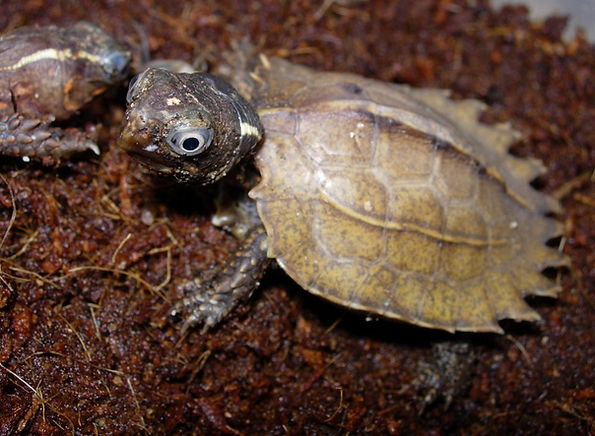
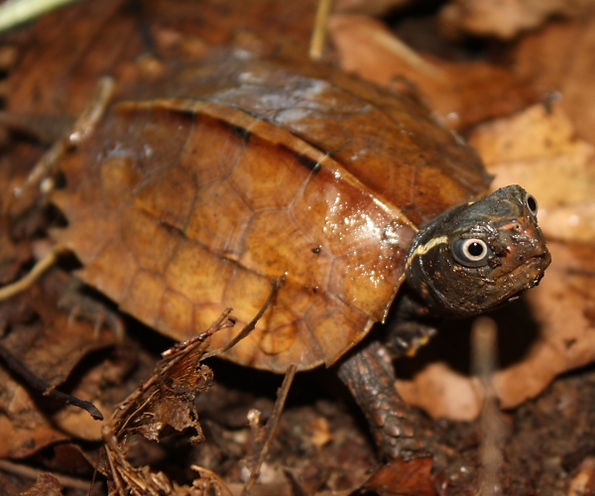
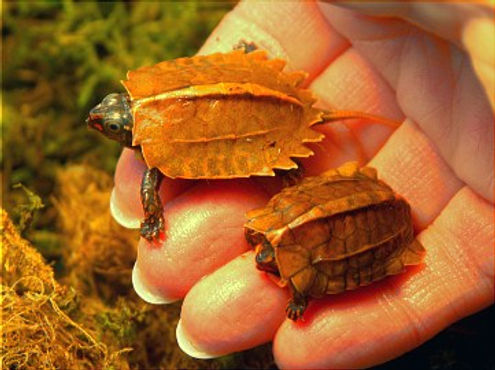
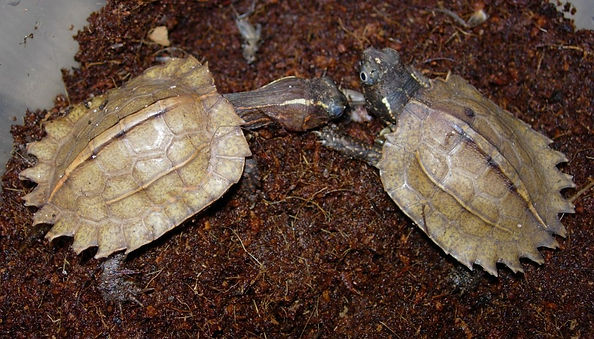
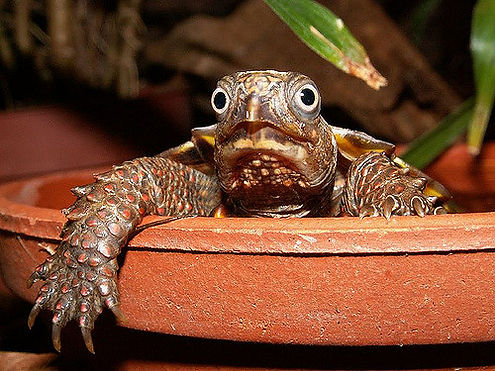
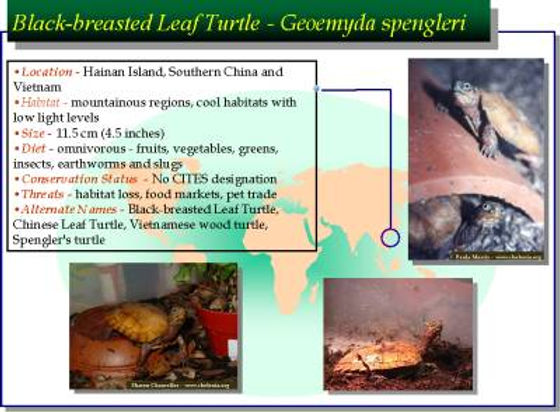
Contrary to what some references say about spengleri not being fond of water, I and other keepers have found that they’re quite happy to sit in their water for periods of time. Again, given the territoriality of these turtles, I advise having at least one water dish more than the number of turtles you are keeping in the pen. The alpha female at one zoo has to be temporarily removed from the display’s only water source (a pool beneath a trickling waterfall) so that the other turtles can drink and soak. Even something as small as a plastic Rubbermaid® sandwich container that each turtle can immerse itself in and soak in peace will be welcomed. I have seen the alphas in my groups try to chase away others from their favorite dishes. Having small, multiple water sources in addition to one large communal dish will allow all to stay hydrated, especially important for this species.
Breaking up the “vista” in an enclosure with plants, rocks and shelters gives each turtle a chance to feel safe from the others, provides interesting contour, and a chance to wear down the claws. Males like to be ‘lookouts’, taking the highest position available in a habitat. Alpha females may do this also. Providing an especially elevated spot will be much appreciated by your spengleri.
I use terra cotta roof tiles for shelters (see photo). These can be laid side-by-side and partially covered with a substrate of sterile potting soil (no perlite or vermiculite) and orchid bark. A third roof tile can added atop the other two after filling in the crevice with substrate. Plants of a vine-y nature provide additional shelter and pleasant greenery.
The G. spengleri favor subdued light (those owl eyes of theirs) and do not like to be too warm a temperature; they must be allowed to retreat to a dark, unheated area of their containment. They can tolerate temperatures between 68-80F. Humidity can come from their water dishes and spritzing with a plant mister a couple of times a day. But they do like a bit of basking heat, so have available during daylight hours a low-wattage basking heat lamp (40-Watt) for thermoregulation.
You can always make a spengleri happy by offering a variety of invertebrates, foremost among which are the night crawlers; they love to hunt anything that moves. Snails and calcium dusted crickets are also favorites. Offer mealworms, but in moderation; they’re not that nutritious and their chitinous exoskeletons could lead to impaction.
After having my group for three years I’m now able to give them fruit and vegetables. They favor red fruit like strawberries, red grapes, plums and tomatoes, but I’ve managed to slide in finely chopped ruby yam, diced cucumber and shreds of zucchini. I add calcium powder, vitamins and finely snipped orchard grass (fiber) to this mix and all of them love it. Start offering a variety of fruit and minced vegetables in addition to the live foods and perservere; they’ll eventually come around, particularly drawn by anything red.
Diet:
-
Invertebrates, especially earthworms
-
Fruit and vegetables
Medical :
Primary pathology with the G. spengleri is entamoeba leading to secondary infections leading to sepsis leading to death. Once G. spengleri start to go downhill, they are nearly impossible to recover but are so tough that they hold out for a long time even when their organs are well beyond repair. It is not unusual for necropsy pictures to show classic sepsis lesions loss of functional liver due to abscessation.
Metronidazole is an extremely important aspect of any medical protocols with Asian market chelonia. In holding areas and shipping, terrestrial chelonia are mixed with aquatics which carry entamoeba. This then infects the terrestrials who have little resistance to it leading to mucosal GI erosions. These erosions lead to bacteria in the bloodstream which leads to liver, lung, renal abscesses and subsequently death. Please note: Any administration of drugs should be under qualified veterinary guidance.
Males are weaker than females in this species.
Shell lesions are fairly common in this species. Many shell lesions appear to be the result of being kept at temperatures that are too high. While it seems odd keeping a reptile at cool temps, (68 - 72 F except for the basking area) they thrive in this type of microhabitat.
Turtle and tortoise care research is ongoing. As new information becomes available we share this on the World Chelonian Trust web site at www.chelonia.org. Serious keepers find it to be a benefit to have the support of others who keep these species. Care is discussed in our free online email community, which may be joined from the web address above. Please contact us about the many benefits of becoming a member of the World Chelonian Trust.
24-Yellow Mud Turtle
Kinosternon flavescens
Yellow Mud Turtle care
courtesy to : www.chelonia.org / World chelonian trust
This care sheet is intended only to cover the general care of these species. Further research to best develop a maintenance plan for whichever species you are caring for is essential..
One of the larger Genera in terms of the number of species is Kinosternon – the Mud turtles. Mud turtles can be found from the Canadian Southern border to central South America. These species are more carnivorous than most turtles with a natural diet that relies heavily on fish, snails, crustaceans and insects. While some species of mud turtles can attain a size of 22 cm. (9 inches), the much more commonly seen Kinosternon subrubrum only attains 12 cm (5 inches) maximum.
Present knowledge and technology make Mud turtles easily maintained animals as long as a person is willing to provide some basic requirements. Thanks to the success that breeders are having with these species it is now possible to purchase many of these species as hatchlings from captive born stock. Many of the species are threatened or endangered in nature, do not remove these animals from the wild.
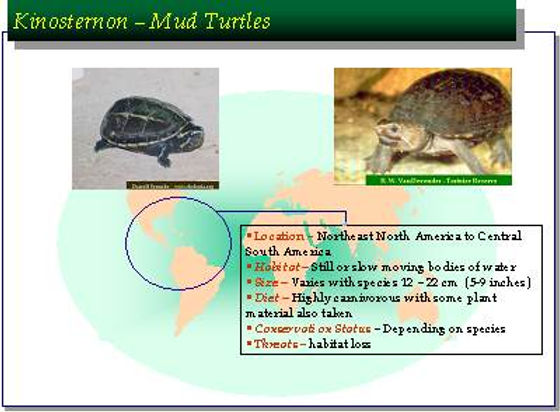
HOUSING MUD TURTLES INDOORS :
The most useful form of indoor accommodation for Kinosternon consists of an aquarium. Mud turtles do a great deal of “bottom walking”, because of this I suggest using shallow water to allow them to easily reach the surface to breathe. For hatchlings I would suggest a water depth of 2 to 4 inches (5 to 10 cm) with one end built up with rocks to provide a dry basking spot. It is possible that they will seldom use this. Mud turtles do very little basking but the addition of a shelf just below the surface of the water gives them another option to bask – in this case without leaving the water. A reasonable size aquarium for a hatchling is a 20 gallon: 30 inches by 12 inches, (75 cm by 30 cm). As the animal grows the size of this habitat should be increased. Water depth is not as critical as they get older but again, it should be remembered that they spend most of their time on the bottom so exceptional depth may stress them. A depth between 8 inches and 12 inches (20 cm to 30 cm) would be fine for adult turtles, which are between 4 inches (10 cm) and 9 inches (22 cm) , depending on the species. In addition a hiding place or cave under the surface of the water is something that will be readily used and lower stress. Make certain if this is made out of rockwork that it cannot collapse on the turtle. I find that half of a flowerpot works well for this purpose.
Water quality is very important. Many problems with aquatic turtles can be averted if one spends a little time and money designing and purchasing an adequate filtration system for your pets. For adult Mud turtles we advise canister filters as they are easily cleaned and provide for excellent water quality. Hatchlings are more difficult to provide good filtration for because of the depth of the water, for these a submersible foam filter or power filter and frequent water changes is the rule.
While Mud turtles have been successfully reared without providing basking facilities I feel that the addition does not hurt them in any way and, in fact, may help to promote more natural day / night activity. Also if live plants are used lighting is , of course, necessary. In one corner of the environment a hardware store reflector clip light lamp should be positioned over a dry basking area and the slightly submerged shelf to provide artificial basking facilities. This should be positioned to provide a basking spot of 90 degrees F or so (32 degrees C) in that section of the habitat. The habitat may also be equipped with a full spectrum fluorescent light to provide for UVB. A UVB source is necessary for Vitamin D3 syntheses (needed in calcium metabolism). If preferred to this lighting arrangement a Mercury vapor bulb may be used that fulfills all requirements though the expense of this would possibly be better spent on a better filter apparatus with this species. Live or plastic aquatic plants are suggested to provide a sense of security and hiding places.
OUTDOOR HOUSING - Predator proof outdoor habitats offer many advantages over indoor accommodations and should seriously be considered as an option during warm weather. A child’s wading pool sunk into the ground in a secure enclosure makes for a serviceable outdoor habitat. Larger ponds with advanced filtration can be used to provide a spectacular outdoor home for your Mud turtle.
DIET. Be careful not to overfeed your Kinosternon. I recommend only feeding 2 to 3 times a week for adult turtles and every day or every other day for the rapidly growing hatchlings. Mud turtles are highly carnivorous: crayfish, snails, insects and worms may make up a large part of their diet. Some vegetable matter such as duckweed is also taken. Many of the commercially prepared turtle diets that exist on the market today are excellent Mud turtle food. As most prepared foods float it may take a while for the turtle to recognize these as food because they forage on the bottom. Allow the food to sink and remain on the bottom for a time prior to cleaning because of this foraging adaptation.
Additional calcium supplementation is essential. Powdered calcium can be sprinkled all foods. It is suggested that one use calcium supplemented with vitamin D3 if the animal is being maintained indoors and calcium without D3 if it is outdoors. Provision of a cuttlefish bone, which can be gnawed if desired, is also recommended. Addition of multivitamins if a commercially prepared turtle diet and/or live fish are NOT used is essential for proper fat metabolism. The freezing process for fish destroys the vitamin E which is an important component for maintaining a healthy Mud turtle.
Some of these species hibernate in nature. After careful research of methods used to safely do this, hibernation facilities may be provided for those that do so.
It should be noted that turtle and tortoise care research is ongoing. As new information becomes available we share this on the World Chelonian Trust web site at www.chelonia.org. Serious keepers find it to be a benefit to have the support of others who keep these species. Care is discussed in our free online email community, which may be joined from the web address above. Please contact us about the many benefits of becoming a member of the World Chelonian Trust.
